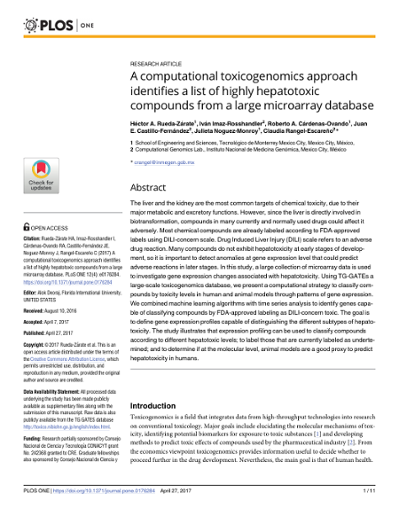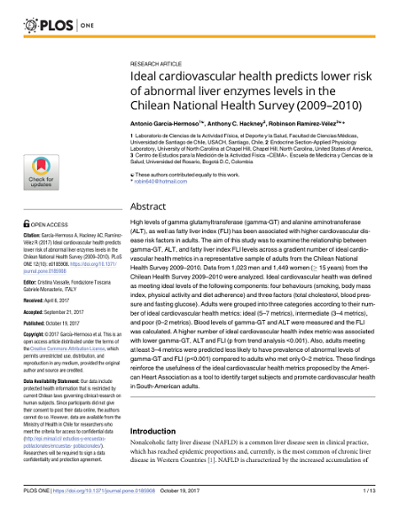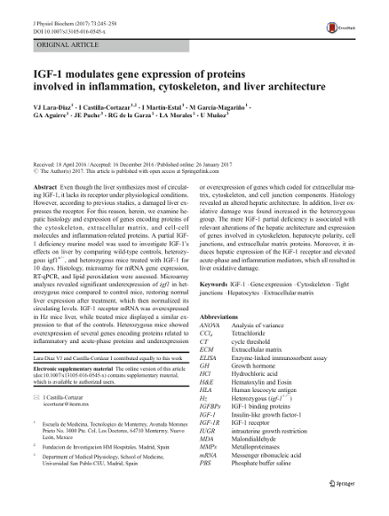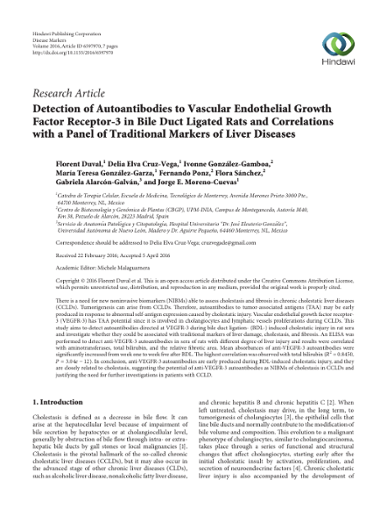Mostrar el registro sencillo del ítem
A computational toxicogenomics approach identifies a list of highly hepatotoxic compounds from a large microarray database
| dc.creator | Juana Julieta Noguez Monroy | |
| dc.date | 2017 | |
| dc.date.accessioned | 2018-10-19T13:37:33Z | |
| dc.date.available | 2018-10-19T13:37:33Z | |
| dc.identifier.issn | 19326203 | |
| dc.identifier.doi | 10.1371/journal.pone.0176284 | |
| dc.identifier.uri | http://hdl.handle.net/11285/630611 | |
| dc.description | The liver and the kidney are the most common targets of chemical toxicity, due to their major metabolic and excretory functions. However, since the liver is directly involved in biotransformation, compounds in many currently and normally used drugs could affect it adversely. Most chemical compounds are already labeled according to FDA-approved labels using DILI-concern scale. Drug Induced Liver Injury (DILI) scale refers to an adverse drug reaction. Many compounds do not exhibit hepatotoxicity at early stages of development, so it is important to detect anomalies at gene expression level that could predict adverse reactions in later stages. In this study, a large collection of microarray data is used to investigate gene expression changes associated with hepatotoxicity. Using TG-GATEs a large-scale toxicogenomics database, we present a computational strategy to classify compounds by toxicity levels in human and animal models through patterns of gene expression. We combined machine learning algorithms with time series analysis to identify genes capable of classifying compounds by FDA-approved labeling as DILI-concern toxic. The goal is to define gene expression profiles capable of distinguishing the different subtypes of hepatotoxicity. The study illustrates that expression profiling can be used to classify compounds according to different hepatotoxic levels; to label those that are currently labeled as undertemined; and to determine if at the molecular level, animal models are a good proxy to predict hepatotoxicity in humans. © 2017 Rueda-Zárate et al. This is an open access article distributed under the terms of the Creative Commons Attribution License, which permits unrestricted use, distribution, and reproduction in any medium, provided the original author and source are credited. | |
| dc.language | eng | |
| dc.publisher | Public Library of Science | |
| dc.relation | https://www.scopus.com/inward/record.uri?eid=2-s2.0-85018256480&doi=10.1371%2fjournal.pone.0176284&partnerID=40&md5=83b012af09a54d86e76001438bf68e0d | |
| dc.relation | Investigadores | |
| dc.relation | Estudiantes | |
| dc.rights | info:eu-repo/semantics/openAccess | |
| dc.rights.uri | http://creativecommons.org/licenses/by-nc-nd/4.0 | |
| dc.source | PLoS ONE | |
| dc.subject | 1 naphthyl isothiocyanate | |
| dc.subject | acetylsalicylic acid | |
| dc.subject | allopurinol | |
| dc.subject | allyl alcohol | |
| dc.subject | amiodarone | |
| dc.subject | azathioprine | |
| dc.subject | benzbromarone | |
| dc.subject | bromobenzene | |
| dc.subject | carbamazepine | |
| dc.subject | carbon tetrachloride | |
| dc.subject | chlorpromazine | |
| dc.subject | cimetidine | |
| dc.subject | clofibrate | |
| dc.subject | coumarin | |
| dc.subject | cyclophosphamide | |
| dc.subject | cytochrome P450 family 1 | |
| dc.subject | diazepam | |
| dc.subject | diclofenac | |
| dc.subject | doxepin | |
| dc.subject | ethionine | |
| dc.subject | fluphenazine | |
| dc.subject | flutamide | |
| dc.subject | gemfibrozil | |
| dc.subject | glibenclamide | |
| dc.subject | griseofulvin | |
| dc.subject | haloperidol | |
| dc.subject | hexachlorobenzene | |
| dc.subject | indometacin | |
| dc.subject | paracetamol | |
| dc.subject | unindexed drug | |
| dc.subject | cytotoxin | |
| dc.subject | algorithm | |
| dc.subject | Article | |
| dc.subject | cluster analysis | |
| dc.subject | data base | |
| dc.subject | gene expression | |
| dc.subject | genomics | |
| dc.subject | human | |
| dc.subject | liver cell | |
| dc.subject | liver toxicity | |
| dc.subject | machine learning | |
| dc.subject | microarray analysis | |
| dc.subject | nonhuman | |
| dc.subject | skin absorption | |
| dc.subject | toxic hepatitis | |
| dc.subject | xenobiotic metabolism | |
| dc.subject | animal | |
| dc.subject | DNA microarray | |
| dc.subject | dose response | |
| dc.subject | drug effects | |
| dc.subject | genetic database | |
| dc.subject | genetics | |
| dc.subject | genomics | |
| dc.subject | liver | |
| dc.subject | metabolism | |
| dc.subject | mouse | |
| dc.subject | preclinical study | |
| dc.subject | procedures | |
| dc.subject | time factor | |
| dc.subject | toxicogenetics | |
| dc.subject | unsupervised machine learning | |
| dc.subject | Animals | |
| dc.subject | Chemical and Drug Induced Liver Injury | |
| dc.subject | Cytotoxins | |
| dc.subject | Databases, Genetic | |
| dc.subject | Dose-Response Relationship, Drug | |
| dc.subject | Drug Evaluation, Preclinical | |
| dc.subject | Genomics | |
| dc.subject | Humans | |
| dc.subject | Liver | |
| dc.subject | Mice | |
| dc.subject | Oligonucleotide Array Sequence Analysis | |
| dc.subject | Time Factors | |
| dc.subject | Toxicogenetics | |
| dc.subject | Unsupervised Machine Learning | |
| dc.subject.classification | 7 INGENIERÍA Y TECNOLOGÍA | |
| dc.title | A computational toxicogenomics approach identifies a list of highly hepatotoxic compounds from a large microarray database | |
| dc.type | Artículo | |
| dc.identifier.volume | 12 | |
| dc.identifier.issue | 4 | |
| refterms.dateFOA | 2018-10-19T13:37:33Z |
Ficheros en el ítem
Este ítem aparece en la(s) siguiente(s) colección(ones)
-
Artículo 1151
Article




